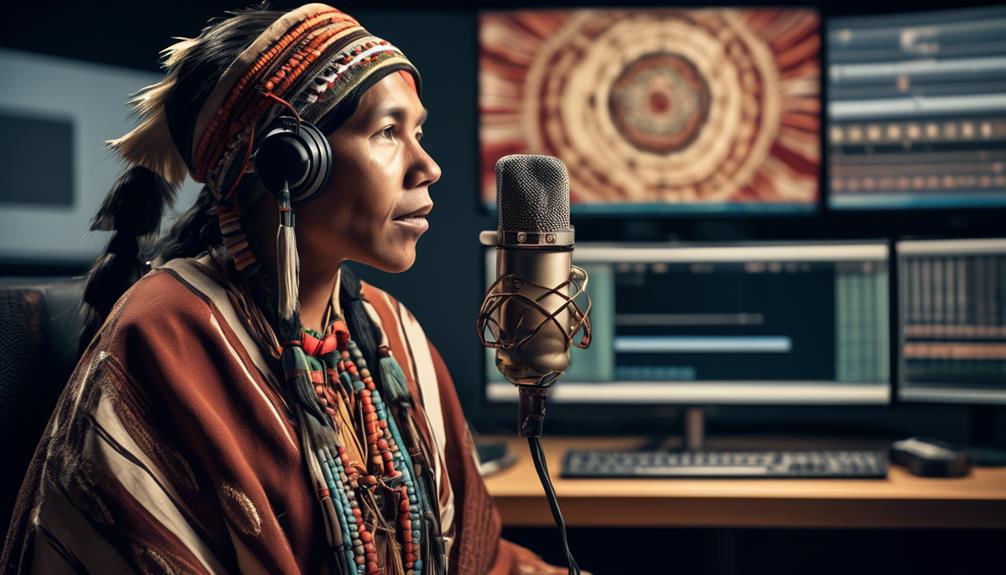Meriam Mir and Kala Lagaw Ya are essential languages of the Torres Strait that represent rich cultural identities for Indigenous communities. They are more than just communication tools; they carry stories, traditions, and historical connection to land and sea. Despite challenges like declining speakers, efforts are underway to preserve and revitalise these dialects through community programs. Exploring further reveals how supporting these languages helps keep Torres Strait’s unique cultural heritage alive for future generations.
Key Takeaways
- Meriam Mir and Kala Lagaw Ya are vital languages of the Torres Strait, reflecting rich cultural identities.
- These dialects face challenges from external influences and declining speakers, requiring revitalization efforts.
- Language preserves community history, traditions, stories, and spiritual beliefs, fostering pride and belonging.
- Preservation initiatives include community classes, recordings, and integration into storytelling and ceremonies.
- Supporting these languages sustains cultural diversity, connects past and future, and promotes indigenous resilience.

Have you ever wondered how diverse the languages of the Torres Strait are? It’s a fascinating tapestry of dialects, each carrying its own history, stories, and cultural significance. Among these, Meriam Mir and Kala Lagaw Ya stand out as essential expressions of the region’s cultural identity. These languages aren’t just means of communication; they are the heartbeat of the communities that speak them, connecting generations and preserving unique worldviews. As you learn about these languages, you’ll realize that language preservation isn’t just about maintaining words or grammar—it’s about safeguarding the cultural essence embedded in every phrase and tradition. When languages like Meriam Mir and Kala Lagaw Ya face challenges from external influences and declining numbers of speakers, efforts to revitalize and keep these languages alive become even more important. They serve as a shield against cultural erosion, making certain that the stories, songs, and customs tied to these languages continue to thrive. Recognizing the importance of language preservation helps emphasize the need to support community-led initiatives that sustain these vital dialects.
You might find that speaking or understanding Meriam Mir and Kala Lagaw Ya empowers communities to reclaim their identity and resist cultural homogenization. These languages carry the collective memory of ancestors, the wisdom about land and sea, and the spiritual beliefs that define the Torres Strait peoples. By supporting language preservation initiatives—such as community classes, recordings, and educational programs—you actively contribute to the resilience of these languages. It’s not just about words; it’s about fostering pride and a sense of belonging among community members. When you witness the use of Meriam Mir and Kala Lagaw Ya in storytelling, ceremonies, or daily life, you’ll see how deeply intertwined language and cultural identity are. They reinforce a shared sense of purpose and history, anchoring communities in their roots while managing modern challenges.
Furthermore, embracing these languages helps bridge the past and present, making sure that traditional knowledge isn’t lost to history. As you become more aware of their importance, you might also feel inspired to support initiatives that promote language learning and documentation. This effort is essential because language preservation sustains the cultural diversity of the Torres Strait and enriches Australia’s broader heritage. When you recognize the significance of Meriam Mir and Kala Lagaw Ya, you contribute to a larger movement that respects indigenous knowledge and celebrates linguistic diversity. Ultimately, these languages are more than words—they are living symbols of resilience, identity, and cultural pride in the Torres Strait communities. Your awareness and actions can help make certain they continue to be spoken and celebrated for generations to come.
Frequently Asked Questions
How Many Speakers Does Each Language Currently Have?
You’ll find that Meriam Mir has roughly 1,200 speakers, while Kala Lagaw Ya has about 2,000. Both languages face challenges in speaker demographics, which impact their significance. Ongoing language revitalization efforts aim to support these communities, encouraging younger generations to learn and use their traditional languages. By actively promoting language use, you help preserve these cultural treasures for future generations, ensuring their continued existence and cultural identity.
Are Meriam Mir and Kala Lagaw Ya Mutually Intelligible?
You’ll find that Meriam Mir and Kala Lagaw Ya aren’t mutually intelligible, despite sharing some language similarities. About 3,000 speakers use Meriam Mir, while Kala Lagaw Ya has around 2,000. These languages have distinct vocabularies and pronunciation styles, making mutual understanding quite limited. Their differences highlight how each language reflects unique cultural identities, even though they coexist within the Torres Strait community.
What Efforts Are Underway to Preserve These Languages?
You can participate in language revitalization efforts by supporting community initiatives that aim to preserve Meriam Mir and Kala Lagaw Ya. These initiatives include teaching programs, cultural events, and the development of educational resources. Community-led projects focus on passing down the languages to younger generations, ensuring their survival. By engaging with these efforts, you help maintain the rich cultural heritage and keep these languages alive for future generations.
How Do These Languages Influence Torres Strait Islander Culture?
You influence Torres Strait Islander culture deeply through Meriam Mir and Kala Lagaw Ya by shaping cultural identity and preserving traditional storytelling. These languages carry stories, customs, and beliefs that connect you to your ancestors and community. Speaking and passing on these languages strengthens cultural pride and continuity, ensuring that your unique heritage remains alive and vibrant for future generations. Your use of these languages keeps the cultural legacy strong and meaningful.
Are There Written Forms of Meriam Mir and Kala Lagaw Ya?
You’ll find that both Meriam Mir and Kala Lagaw Ya have limited written forms, but efforts are underway to develop orthographic standards through language documentation. While historically oral, these languages are increasingly being captured in written form to safeguard their rich cultural heritage. This ongoing process helps guarantee the languages are accessible and can thrive for future generations, blending tradition with modern preservation techniques.
Conclusion
Just like the legendary stories whispered by the winds of the Torres Strait, Meriam Mir and Kala Lagaw Ya carry the soul of their people. Preserving these languages keeps their history alive, much like a lighthouse guiding future generations through the fog. Remember, every word spoken is a thread in the vibrant tapestry of their culture. Hold onto these voices—they’re the echoes of ancestors and the promise of tomorrow’s stories.
Mary is a passionate writer who brings creativity and a fresh perspective to our team. Her words have the power to captivate and inspire, making her an essential contributor to our content. Mary’s commitment to storytelling and dedication to promoting Indigenous culture ensures that her work touches the hearts of our readers. We’re fortunate to have her as part of our team.










